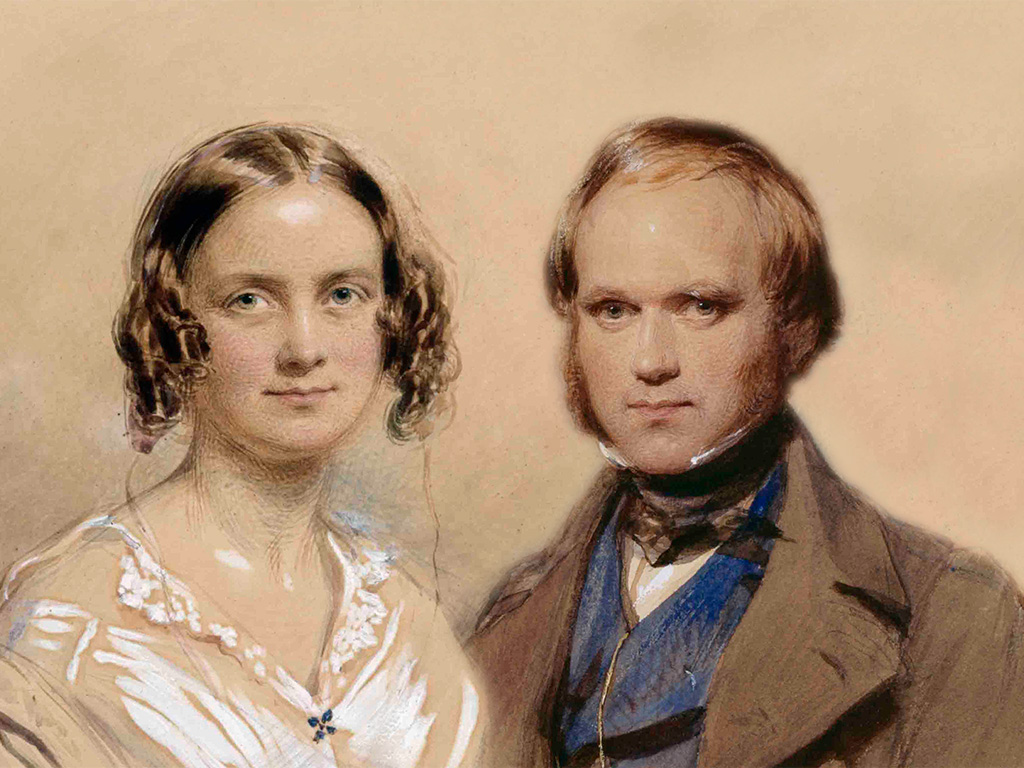On 29th January 1839, after a short courtship and engagement, Charles Darwin married his cousin Emma Wedgwood at St Peter’s Church, Maer, Staffordshire.
The bride wore a greenish-grey rich silk dress, and white clipped bonnet trimmed with blonde and flowers. The presiding local vicar was John Allen Wedgwood, another cousin. After the ceremony, the happy couple immediately rushed away to their new home in Gower Street, London.

(Composite image from two contemporaneous portraits by George Richmond.)
Before deciding to seek a wife, Darwin famously made a list outlining the pros and cons of marriage, romantically concluding, amongst other compelling reasons for getting hitched, that a wife would make a better companion than a dog.
During their brief engagement, Charles and Emma corresponded about their differing religious views. The devout Emma was concerned about being separated from her future husband in the afterlife, but sensibly concluded ‘honest and conscientious [religious] doubts cannot be a sin’. It seems likely that concerns over Emma’s religious sensitivities remained an important factor in Darwin seldom openly expressing views on religious matters throughout the rest of his life.
Inter-cousin marriages were far more common in the nineteenth century, particularly in wealthy families. But the fact Charles and Emma continued a line of inter-cousin marriages going back a number of generations was to become a huge concern for Darwin, whose work on species later convinced him of the undesirability of close inter-breeding.
Despite these concerns, Emma and Charles Darwin’s marriage was a long and happy one, as their affectionate correspondence on the rare occasions they were apart demonstrates. They had ten children, seven of whom survived into adulthood. They read novels and played backgammon together in the evenings. And Emma was to become Charles’s devoted nurse during his chronic illness. Appropriately, she was there with him in the end. He died in her arms after a devoted marriage of 43 years.
Was Emma Wedgewood related to the Wedgewood China family?
If so in what way ?
Thanks
LC
Yes, she was. Her grandfather Josiah Wedgwood I founded the company, and her father, Josiah Wedgwood II, continued running it until her elder brother took over. (No prizes for guessing his name!)
Not only the bride was a granddaughter of Josiah Wedgwood, so was the groom - the groom's and bride's mother and father were brother and sister! They don't like to tell you that fact.
The wording of your comment might be misconstrued to mean brother married sister, which obviously wasn't the case. But, yes, the Darwin-Wedgwood family tree was famously convoluted and tight-knit, with cousins marrying cousins over more than one generation. This was fairly common practice in rich families at the time. But the family’s in-breeding was of considerable concern to Charles Darwin in later life, when he began to realise the problems this could cause. He was particularly worried his health problems might have been caused by in-breeding, and might be inherited by his children.
"One day, on tearing off some old bark, I saw two rare beetles, and seized one in each hand. Then I saw a third and new kind, which I could not bear to lose, so I popped the one which I held in my right hand into my mouth. Alas! it ejected some intensely acrid fluid, which burnt my tongue so that I was forced to spit the beetle out, which was lost, as was the third one."
- Charles Darwin
The life and letters of Charles Darwin...ed. by his son, Francis Darwin. 2 v (ed. 1898)
It was a Bombardier Beetle he put in his mouth before identifying it. LMAO
But the results of this first cousin marriage were not disastrous. 7 out of their 10 children survived into adulthood, all lived until ages between 67 and 93. This was not bad for that time, and the youngest was defective and was among those who died in infancy probably due to Emma's advanced age of 48, old for a woman to have a baby even today. And four of their sons became distinguished scientists, three of them became Fellows of the Royal Society.
Yes, but some of the Darwin’s children suffered from medical conditions that Darwin himself thought to be inherited from him. His daughter Henrietta was frequently poorly in her youth, as were at least two of his sons. Darwin did not think in-breeding was (necessarily) immediately disastrous, but something that was detrimental if prolonged over generations—as it had been in his own family. He was so concerned about this issue that he tried (unsuccessfully) to have a question about close-relatedness of parents included in the UK national census.